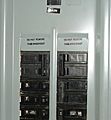Distribution board facts for kids
A distribution board is a super important part of your home's electrical system. Think of it like the main control center for all the electricity in your house! It takes the main power coming into your home and splits it into many smaller circuits. Each circuit then powers different parts of your house, like your lights, TV, or kitchen appliances.
The best part about a distribution board is that it keeps you safe. Each circuit has its own special protection system, usually a fuse or a circuit breaker. These devices are like tiny guardians. If too much electricity tries to flow through a circuit, they quickly stop the power. This prevents damage to your appliances and, most importantly, helps prevent electrical fires or shocks.
Contents
What is a Distribution Board?
A distribution board is often called a breaker box or fuse box. It's a metal box, usually found in a basement, garage, or utility closet. Inside, you'll see rows of switches or small cylinders. These are the circuit breakers or fuses.
The main power line from the street comes into this box first. Then, the power is divided into smaller lines. Each of these smaller lines goes to a specific area or group of outlets in your home. For example, all the lights in your living room might be on one circuit, while the kitchen outlets are on another.
Why are Distribution Boards Important for Safety?
Electricity is powerful and can be dangerous if not controlled. A distribution board plays a huge role in keeping your home and family safe.
Protecting Against Overloads
Imagine plugging too many things into one outlet, like a toaster, a microwave, and a coffee maker all at once. This can draw too much electricity, creating an "overload." If this happens, the wires inside your walls could get very hot. This heat can melt the wire's insulation and even start a fire.
This is where the distribution board's safety devices step in. When an overload happens, the fuse melts or the circuit breaker "trips" (switches off). This immediately cuts off the power to that circuit, preventing the wires from overheating and keeping everyone safe.
Preventing Short Circuits
A "short circuit" happens when electricity takes an unintended, shorter path. This can occur if wires are damaged or if water gets into an electrical device. Short circuits can cause a sudden, huge surge of electricity.
Just like with overloads, the distribution board's fuses or circuit breakers detect this sudden surge. They quickly cut the power, stopping the dangerous flow of electricity and protecting your home from damage or fire.
How Do Fuses and Circuit Breakers Work?
Both fuses and circuit breakers do the same job: they stop the flow of electricity when there's a problem. But they do it in slightly different ways.
Fuses
An older type of protection is a fuse. A fuse contains a thin wire designed to melt and break if too much electricity flows through it. Once a fuse melts, it needs to be replaced with a new one. You can't reuse a melted fuse.
Circuit Breakers
Most modern homes use circuit breakers. These are like reusable switches. When too much electricity flows, the circuit breaker automatically "trips" to the "off" position. This stops the power. To get the power back on, you just need to flip the breaker switch back to the "on" position after fixing the problem that caused it to trip. This makes them very convenient.
Types of Distribution Boards
Distribution boards have changed over time. Older homes might still have fuse boxes, while newer homes almost always have circuit breaker panels.
Main Service Panels
The main distribution board in your home is called the main service panel. This is where the electricity first enters your house and is then distributed to all the different circuits. It usually contains a main breaker that can shut off all power to the entire house.
Subpanels
Sometimes, larger homes or homes with additions might have subpanels. These are smaller distribution boards that get their power from the main service panel. They are used to distribute power to a specific area, like a garage, a workshop, or a new extension of the house. This helps manage the electricity more efficiently in larger spaces.
History of Distribution Boards
Early electrical systems were very simple, often with just one main circuit. As homes started using more and more electrical devices, the need for better organization and safety became clear. The first fuse boxes appeared in the late 1800s. They were simple but effective at preventing fires.
Over time, technology improved. Circuit breakers were invented, offering a more convenient and reusable way to protect circuits. Modern distribution boards are highly advanced, designed to keep up with the many electrical needs of today's homes while ensuring maximum safety.
Images for kids
See also
 In Spanish: Cuadro de distribución para niños
In Spanish: Cuadro de distribución para niños











